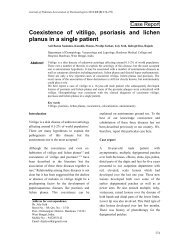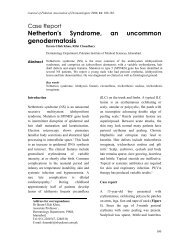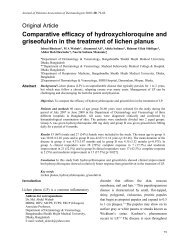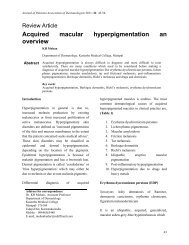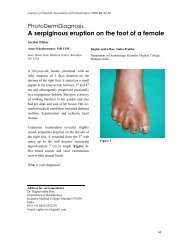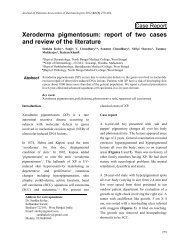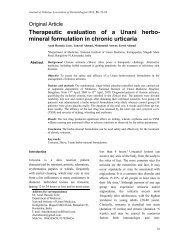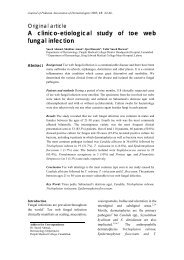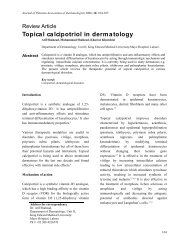Review Article Pathogenesis Of acne Vulgaris: Simplified - JPAD
Review Article Pathogenesis Of acne Vulgaris: Simplified - JPAD
Review Article Pathogenesis Of acne Vulgaris: Simplified - JPAD
Create successful ePaper yourself
Turn your PDF publications into a flip-book with our unique Google optimized e-Paper software.
Journal of Pakistan Association of Dermatologists 2010; 20: 93-97.<br />
<strong>Review</strong> <strong>Article</strong><br />
<strong>Pathogenesis</strong> of <strong>acne</strong> vulgaris: simplified<br />
Ch. Muhammad Tahir<br />
Consultant Dermatologist, WAPDA Hospital Complex, Lahore.<br />
Abstract Acne vulgaris is a common chronic inflammatory disease of the pilosebaceous unit. It is<br />
characterized by the formation of non-inflammatory comedones and inflammatory papules,<br />
pustules, nodules and cysts. Acne is extremely common and usually starts during the teenage years<br />
but can start for the first time in their 20s and 30s. The lesions usually involve the face, back and<br />
chest. Severe inflammation may lead to scarring after healing. Psychosocial impact of <strong>acne</strong> can be<br />
tremendous and lead to a poorer quality of life. Proper understanding of pathogenesis of <strong>acne</strong> will<br />
lead to better management.<br />
Introduction<br />
Key words<br />
Acne vulgaris, pathogenesis, Propionibacterium <strong>acne</strong>s.<br />
Acne vulgaris is a disease of pilosebaceous unit<br />
characterized by the formation of open and<br />
closed comedones, papules, pustules, nodules<br />
and cysts. It is the most common disorder treated<br />
by dermatologists. 1<br />
The term <strong>acne</strong> is derived from Greek word<br />
“acme” which means “prime of life”. Although<br />
generally considered to be a benign, self limiting<br />
condition, <strong>acne</strong> may cause severe psychological<br />
problems or disfiguring scars that can persist for<br />
a lifetime. 2<br />
It is a pleomorphic disorder and can manifest at<br />
any time during life 3 but it most commonly<br />
presents between ages of 12-24, which estimates<br />
of 85% of population affected. 3 In recent years<br />
multifactorial nature of <strong>acne</strong> has been<br />
elucidated. An improved understanding of the<br />
pathophysiology of <strong>acne</strong> leads to rational<br />
therapy for successful treatment. 4<br />
Address for correspondence<br />
Dr. Ch. Muhammad Tahir,<br />
Consultant Dermatologist<br />
WAPDA Medical Complex,<br />
Ferozpur Road, Lahore<br />
Email: drtahirchskin@hotmail.com<br />
<strong>Pathogenesis</strong> of <strong>acne</strong> vulgaris<br />
The precise mechanisms of <strong>acne</strong> are not known<br />
but there are four major pathogenic factors 5 : 1.<br />
increased sebum production; 2.<br />
hypercornification of pilosebaceous duct, 3.<br />
abnormal bacterial function; and 4. production<br />
of inflammation (Figures 1 and 2).<br />
1. Increased sebum production<br />
Role of sebaceous glands in the pathogenesis of<br />
<strong>acne</strong> has long been recognized, so much so that<br />
the disease is standardly classified as a<br />
sebaceous gland disorder. However, such a<br />
designation is oversimplification. 6<br />
Pilosebaceous unit, the ‘seat’ of <strong>acne</strong>, is cell<br />
lined follicle with large sebaceous gland and a<br />
fine vellus hair that rarely extends out of follicle.<br />
These are most common in the <strong>acne</strong> prone areas<br />
such as cheek, nose and forehead and also on the<br />
chest and back. 4<br />
Increased rate of sebum production is one of the<br />
most important factors involved in the<br />
development of <strong>acne</strong> lesions. As a group,<br />
patients with <strong>acne</strong> secrete more sebum than<br />
normal individuals and severity of <strong>acne</strong> is<br />
93
Journal of Pakistan Association of Dermatologists 2010; 20: 93-97.<br />
Androgens<br />
Abnormal follicular keratinization Increased sebum production<br />
Obstruction<br />
P. <strong>acne</strong>s<br />
Noninflammatory lesions (comedones) Inflammatory lesions (papules, pustules, nodules)<br />
P. <strong>acne</strong>s<br />
Figure 1 Basic mechanisms involved in the pathogenesis of <strong>acne</strong>.<br />
related to the degree of seborrhea which is<br />
directly dependant on the size and rate of growth<br />
of sebaceous glands, which is under the control<br />
of androgens. 7<br />
Elevated serum levels of free testosterone were<br />
noted in <strong>acne</strong> patients, which correlated with<br />
<strong>acne</strong> lesions. Free testosterone is the only<br />
parameter which may be used diagnostically in<br />
males. A positive correlation exists between<br />
androgens and <strong>acne</strong> lesions in males. A positive<br />
correlation between androgens and <strong>acne</strong> lesions<br />
in females points to the importance of peripheral<br />
hormone action in the skin. 8<br />
Increased sebum production characteristic of<br />
patients with <strong>acne</strong> is often due to end-organ<br />
hyper response. 5 Differential peripheral<br />
conversion of testosterone to<br />
dihydrotestosterone may explain why glands in<br />
sebaceous areas enlarge at puberty. Plasma<br />
testosterone levels are usually elevated in<br />
females with nodulocystic <strong>acne</strong>. 1<br />
One possible role of sebum in the pathogenesis<br />
of <strong>acne</strong> is its primary or associative role in<br />
comedogenesis. 6 Another indisputable role for<br />
sebum is providing the substrate for P. <strong>acne</strong>s<br />
growth, specifically triglyceride acted upon by<br />
P. <strong>acne</strong>s lipase to form diglycerides, P. <strong>acne</strong>s<br />
lipase to form diglycerides, monoglycerides and<br />
free fatty acids from which glycerol, the<br />
utilizable moiety for P. <strong>acne</strong>s metabolism is<br />
formed. 9<br />
2. Hypercornification of the pilosebaceous duct<br />
Obstruction of the pilosebaceous canal precedes<br />
the development of <strong>acne</strong> lesions. The obstruction<br />
is produced by the accumulation of adherent<br />
keratinized cells within the canal that form an<br />
impaction obstructing the flow of sebum. Cause<br />
is unknown but the process may be under the<br />
influence of androgens. 2 It may also be due to an<br />
abnormality in the sebaceous lipids resulting in a<br />
relative hyperproliferation of corneocytes. 8<br />
Comedone formation may be due to a localized<br />
deficiency of linoleic acid in pilosebaceous duct.<br />
Linoleic acid is incorporated via plasma into<br />
sebaceous gland cells, where it is diluted due to<br />
large volume of sebum and the ductal<br />
corneocytes are effectively bathed in an<br />
inadequately low level of linoleic acid. 5<br />
As the follicular lumen becomes obstructed by<br />
abnormally desquamated follicular cells, sebum<br />
gets trapped behind the hyperkeratotic plugs,<br />
dilating the follicle. Normal follicular<br />
architecture is lost at this point. 4 The end result<br />
94
Journal of Pakistan Association of Dermatologists 2010; 20: 93-97.<br />
Propionibacterium <strong>acne</strong>s<br />
Low molecular weight chemoattractants<br />
Phagocytosis of P. <strong>acne</strong>s by neutrophils Lipase<br />
Release of neutrophilic hydrolytic enzymes Sebum<br />
Protease (hyaluronidase)<br />
Complement activation (C5a) Inflammation<br />
Neutrophil chemoattractants Free fatty<br />
acids<br />
Follicular wall rupture<br />
Repair<br />
Figure 2 Sequence of events leading to <strong>acne</strong> inflammation primarily induced by P. <strong>acne</strong>s [6].<br />
of this hyperkeratinization is the development of<br />
a comedo (pl. comedones) {open comedone =<br />
blackhead and closed comedone = whitehead}.<br />
Microscopically these lesions are dilated<br />
pilosebaceous ducts containing a mixture of<br />
cornified follicular epithelium, sebum, bacteria<br />
and saprophytic yeasts. 7<br />
Premenstrual exacerbation of <strong>acne</strong>, a well<br />
recognized clinical feature, can also be<br />
explained to some extent by changes in duct size<br />
as fluid retention swells keratin.<br />
Biopsy and culture of early non-inflamed lesions<br />
show that 30% of these are without bacteria 10<br />
suggesting that ductal bacteria are not needed for<br />
initiation of cornification.<br />
Foreign bodies<br />
Prime defect in <strong>acne</strong> vulgaris is an increase in<br />
sebum excretion, which in turn leads to bacterial<br />
colonization and infection, which in turn causes<br />
histopathological (and clinical) lesions of <strong>acne</strong> –<br />
a minor component of which is the ductal<br />
changes. Ductal blockage theory is a myth that<br />
persists in the face of all evidence that suggests<br />
the changes interpreted as blockage are<br />
secondary. In particular, there is no evidence<br />
that comedones are primary lesions and the<br />
black headed ones are innocent bystanders on<br />
the pathological primrose-path to papules and<br />
pustules. 8<br />
3. Abnormal bacterial function<br />
Have follicular micro-organisms a role in <strong>acne</strong>?<br />
The answer to this question with present<br />
knowledge is both yes and no. A role of<br />
microorganisms in <strong>acne</strong> has been championed<br />
95
Journal of Pakistan Association of Dermatologists 2010; 20: 93-97.<br />
since the beginning of the 20 th century. Skin<br />
surface in <strong>acne</strong> prone areas are colonized with<br />
Staphylococcus epidermidis and<br />
Propionibacterium <strong>acne</strong>s. Selective inhibitory<br />
studies suggest that the main organism is P.<br />
<strong>acne</strong>s. 5,16<br />
The anaerobic P. <strong>acne</strong>s proliferates in the ideal<br />
environment of the comedo: an obstructed lipid<br />
rich lumen with decreased oxygen tension. 4 This<br />
overgrowth of P. <strong>acne</strong>s hydrolyses sebum<br />
triglycerides, producing free fatty acids which<br />
may lead to microcomedo formation. 11<br />
At present it is not possible to decide whether<br />
the microflora are initiators of the lesions or<br />
whether they take advantage of the habitat in the<br />
lesion, or whether a critical balance of groups of<br />
micro-organisms occupying a follicle is the<br />
essential factor for the <strong>acne</strong>genesis. 5<br />
4. Production of inflammation<br />
The association of P. <strong>acne</strong>s proliferation with<br />
inflammatory lesions of <strong>acne</strong> is best borne out<br />
with the significant suppression of P. <strong>acne</strong>s with<br />
antibiotic therapy. There is a parallel<br />
improvement and decrease in the number of<br />
<strong>acne</strong> lesions. P. <strong>acne</strong>s contributes to<br />
inflammation through activation of various<br />
chemotactic factors, as well as, through<br />
promoting rupture of the comedo. 4<br />
It is not clear why the endogenous bacteria<br />
colonize the sebaceous follicles. P. <strong>acne</strong>s<br />
elaborate a low molecular weight polypeptide 12<br />
that presumably diffuses through abnormally<br />
keratinized follicular epithelium of sebaceous<br />
follicles, still physically intact and attract<br />
polymorphonuclear leucocytes to follicular site.<br />
The intrafollicular P. <strong>acne</strong>s is ingested by<br />
neutrophil, with the consequent release of<br />
hydrolytic enzymes that are thought to effect<br />
follicular wall dyshesion and rupture. This<br />
disruption allows the intrafollicular contents to<br />
escape into surrounding dermis and produce<br />
inflammation. Experimental evidence suggests<br />
that inflammation results from a variety of<br />
insults, such as neutrophilic hydrolytic enzymes,<br />
P. <strong>acne</strong>s enzymes, sebum and foreign bodies<br />
(Figure 2). 6 The combination of keratin, sebum<br />
and microorganism particularly P. <strong>acne</strong>s leads to<br />
release of proinflammatory mediators and<br />
accumulation of T-helper lymphocytes,<br />
neutrophils and foreign body giant cells. This in<br />
turn causes the formation of inflammatory<br />
papules, pustules and nodulocystic lesions.<br />
Early cellular infiltrate is lymphocytic seen<br />
around blood vessels and duct. Within 12-24<br />
hours polymorphonuclear leucocytes appear but<br />
lymphocytes remain in the papule as<br />
predominant cell infiltrate. Ductal rupture is not<br />
a prerequisite for development of inflammation.<br />
The impact of emotional well being and function<br />
can be critical and is associated with depression<br />
and higher than average unemployment rates. 14,15<br />
Proper understanding of pathogenesis of <strong>acne</strong><br />
will lead to successful <strong>acne</strong> management which<br />
necessitates the ability of treating physician to<br />
apply therapy to evolutionary stage of disease.<br />
More than one pathogenic mechanism should be<br />
targeted for treating <strong>acne</strong> lesions.<br />
References<br />
1. Sams WM Jr, Lynch PJ, eds. Principles and<br />
Practice of Dermatology. New York:<br />
Churchill Livingstone; 1990.<br />
2. Leung AK, Robson WL. Acne. J R Soc<br />
Health 1991: 111: 57-60.<br />
3. Winston MH, Shalita AR. Acne vulgaris –<br />
pathogenesis and treatment. Pediatr Clin<br />
North Am 1991; 38: 889-903.<br />
4. Eichenfield LF, Leyden JJ. Acne: Current<br />
concepts of pathogenesis and approach to<br />
96
Journal of Pakistan Association of Dermatologists 2010; 20: 93-97.<br />
rational treatment. Paediatrician 1991; 18:<br />
218-23.<br />
5. Cunliffe WJ, Marks R, eds. Acne. London:<br />
Martin Dunitz; 1989.<br />
6. Pochi PE, The pathogenesis and treatment of<br />
<strong>acne</strong>. Ann Rev Med 1990; 41: 187-98.<br />
7. Lever l, Marks R. Current views on<br />
aetiology, pathogenesis and treatment of<br />
<strong>acne</strong> vulgaris. Drugs 1990; 39: 681-92.<br />
8. Schmidt JB, Spona J, Niebauer G.<br />
Endocrinological involvement in <strong>acne</strong>. In:<br />
Marks R, Plewing G, eds. Acne and Related<br />
Disorder. London: Taylor & Francis; 1989.<br />
P. **<br />
9. Rebello TJ, Hawk LM. Skin surface glycerol<br />
levels in <strong>acne</strong> vulgaris. J Invest Dermatol<br />
1978; 70: 353-4.<br />
10. Leeming JP, Holland KT, Cunliffe WJ. The<br />
pathogenesis and ecological significance of<br />
microorganisms colonizing <strong>acne</strong> vulgaris<br />
comedone. J Med Microbiol 1985; 20: 11-6.<br />
Manuscript Submission<br />
Manuscripts may be emailed to the Editor,<br />
Prof. Dr. Ijaz Hussain,<br />
E mail: drijazhussain@gmail.com.<br />
11. Downing DT, Stewart ME, Wertz PW et al.<br />
Essential fatty acids and <strong>acne</strong>. J Am Acad<br />
Dermatol 1986; 14: 221-5.<br />
12. Puhrel SM, Sakamoto M. The<br />
chemoattractant properties of comedonal<br />
contents. J Invest Dermatol 1978; 70: 353-4.<br />
13. Bergfeld WF. Topical retinoids in<br />
management of <strong>acne</strong> vulgaris. J Drug Dev<br />
Clin Pract 1996; 8: 151-60.<br />
14. Asad F, Qadir A, Ahmad L. Anxiety and<br />
depression in patients with <strong>acne</strong> vulgaris. J<br />
Pak Assoc Dermatol 2002; 12: 69-72.<br />
15. Katsambas AD, Stefanaki C, Cunliffe WJ.<br />
Guidelines for treating <strong>acne</strong>. Clin Dermatol<br />
2004; 22: 439-44.<br />
16. Joo SS, Jang SK, Kim SG et al. Anti-<strong>acne</strong><br />
activity of Selagineela involvens extract and<br />
its non antibiotic anti-microbial potential on<br />
Propionibacterium <strong>acne</strong>s. Phytother Res<br />
2008; 22: 335-9.<br />
97



